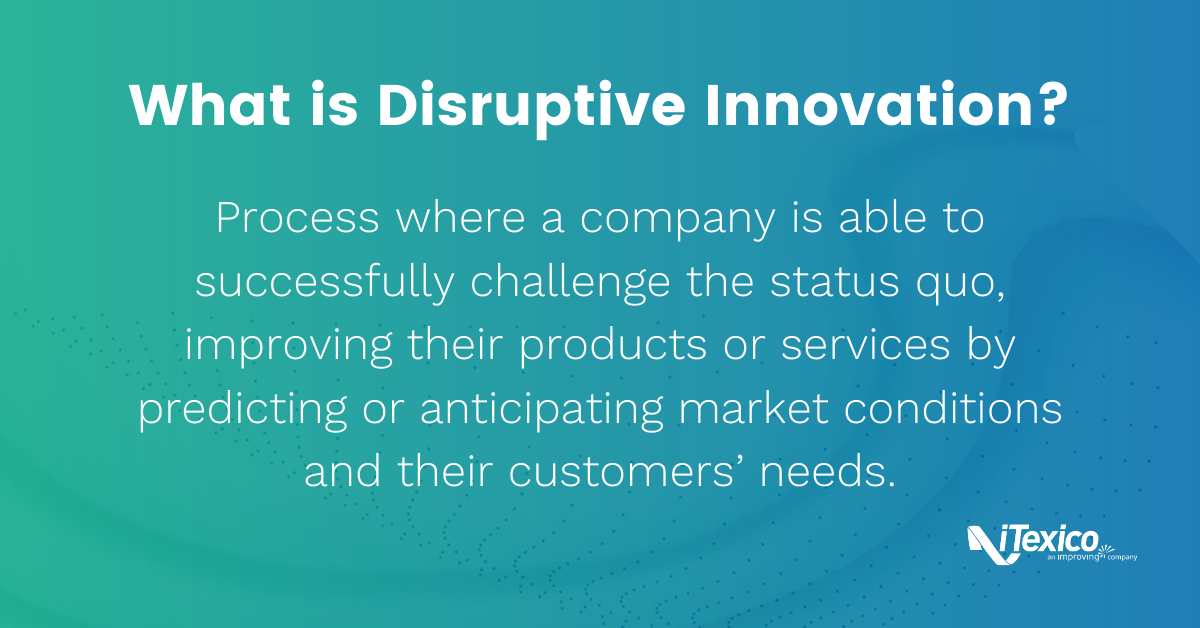Top 5 Disruptive Technologies for 2021
7 minute read
Disruption was the defining characteristic trait of 2020, undeniably. Global business practices had to contend with a sudden, monumental shift between traditional environments to remote work with short notice. A unique brand of adversity, caused by disruptive conditions that impacted every business on a fundamental level, gave rise in turn to innovative, disruptive solutions with long-term consequences.
Though 2020 is coming to a close, the precedents and conditions that defined it will continue to pave the way for 2021 through innovation-driven growth. We risk sounding like a broken record, but business and IT leaders must pivot, change strategies, adapt, and repeat as needed. However, while much remains the same going forward, the past year has provided business leaders with experience, perspective, and hindsight necessary for growth in the current environment.
Spotlighting new technologies that will help your company thrive in the coming year is vital for securing valuable resources in advance. Today we’re going to be talking about 5 disruptive technologies that can help drive growth through innovation. However, before we get there, we have to define disruptive innovation.
What Is Disruptive Innovation?
The terms “disruption” and “disruptive innovation” are colorful, frequently used concepts that can easily spiral out of their intended designations and be used incorrectly. According to Merriam-Webster, disruption is defined as a break or interruption in the normal course or continuation of a process or activity. In context of business procedures, that definition becomes concentrated in the workplace environment.
 Cycling up to defining disruptive innovation, we know it as a process where a company is able to successfully challenge the status quo, improving their products or services by predicting or anticipating market conditions and their customers’ needs. As a measure of foresight and analyzing innovation within your field, it’s an essential practice for catching the flow of the market before your competition does.
Cycling up to defining disruptive innovation, we know it as a process where a company is able to successfully challenge the status quo, improving their products or services by predicting or anticipating market conditions and their customers’ needs. As a measure of foresight and analyzing innovation within your field, it’s an essential practice for catching the flow of the market before your competition does.
An example that sums up the simultaneous success of disruptive innovation and the failure of not predicting the market flow is Netflix and Blockbuster. Blockbuster, for years, was the kingpin of rental movies, dominating the market with a brand that spanned the continent with easily rentable movies, shows, and games. What they underestimated was how powerful and valuable the digital market was.
Believing that any one market or environment will always stay the same has been the downfall of countless companies throughout the years. For Blockbuster, the rampant success Netflix has enjoyed shut them down because they failed to anticipate where the digital market was going thanks to the internet. While there’s a particular, unique experience associated with a video store environment, it cannot replace the variety, accessibility, and functionality of an online digital streaming platform.
What Are the Top 5 Disruptive Technologies for 2021?
The following list will describe 5 technologies that will help businesses anticipate and meet changing customer and market demands during 2021. There are no guarantees with what implementing these technologies will bring for your company, but what’s assured is they’ll provide you with the competitive edge needed to survive and grow over the course of the coming year.
1. Digital Workplace
The office space is an archaic working environment that has long outstayed its necessity and popularity. There are plenty of reasons to have an in-person communal area for your employees, certainly, but what the pandemic has proven more than anything is that remote working is not only necessary, it’s cost-effective and productive. Working from home will outlast COVID-19 as more companies will come to realize the immense benefits and cost-reducing measures it provides.
Before the events of 2020, the very concept of working from home was an unorthodox measure scarcely afforded and prone to negative preconceptions. What was once thought a far reality is now the new way of living for many industries even when we go back to “normal”. Companies are realizing that the digital workplace is the right environment for many employees to thrive and increase productivity, making the digital workplace a thing to stay.
“Perhaps the biggest disruption will be the virtual environment technologies, and not only the technology itself but the processes around how we work in this virtual environment which can lead again to some very interesting development in our nearshore capabilities,” says Curtis Hite, CEO or Improving. “Customers in the U.S. and Canada and across the world are are getting more used to the idea of remote teams, because of the pandemic they’ve almost been forced, people are not coming in to offices and therefore our customers and IT executives across the world are considering ‘Well, where might I get the best value for our dollars?’ and are willing to take a chance themselves. So I think the most disruptive technology to how we think about things today will be the remote environment, the tools to support the remote environment, and the processes which create effectiveness in that remote environment.”
The results of digital workplaces have proven to have huge ramifications already visible within the last year. The transfer between on-site and remote workplaces was, for many companies, unstructured and awkward. However, for those who already had pre-existing remote infrastructures developed as company policy, the sudden shift was smooth, easygoing, and effective compared to their unprepared counterparts. This new dynamic created a divide between those companies who were prepared to contend with catastrophe and those who weren’t and are still playing catch up.
2. Security
Security has always been the lynchpin on providing your company with the reputation and confidence it needs to be a successful corporate entity. No one wants to do business with a company who can’t guarantee the safety and integrity of their data, after all. In light of a whole conflux of events in 2020 took the need for extensive security measures to a whole new level.
Covid was blamed for a 238% surge in cyber attacks on banks. With the digital market and influx of remote work relevance skyrocketing, the amount of vulnerabilities that could be exploited were taken advantage of. As organizations accelerate digital business and the workplace in 2021, security must be center stage on a rapidly changing world stage in order to maintain the integrity of their data and applications.
With fewer people working in their physical offices and sharing the same secure network, companies must upgrade their cybersecurity strategies to protect their work-from-home devices and networks. Investing in remote workplace infrastructure is more than providing your employees with the scheduling, communication, and technological resources to handle their workload. Even from a distance, you need to update and maintain powerful security measures to safeguard both your employees and your network.
3. AI and Big Data
An ever-evolving AI field has been proving its own value for years as continual leaps and bounds in creating, refining, and innovating its technology has led to massive changes in how the digital field operates. For a post-coronavirus world, its benefits and applications have never been more effective or widespread.
AI will continue helping us to understand the world in order to make better decisions. Big data is a huge part currently for certain industries like healthcare, for example, and AI applications such as machine learning can feed from that information and help us spot insights and opportunities. As more individuals and companies alike have turned their attention to the digital landscape, the situations that benefit from leveraging AI and big data are all the more relevant.
Now and going forward, more customer behavioral activity will take place on online platforms, generating a greater influx of discernable information that helps provide insights and guidance that your company can use. Analyzing that data will assist your business in successfully meeting the customers’ demands during 2021.
4. Cloud
The cloud has provided companies with the flexibility, protection, and accessibility to make company-wide remote work a viable, feasible solution. Going forward, continual investment in cloud technology is necessary to broaden support for a new diverse company framework. This includes a mix of public and private SaaS and on-premise solutions to help organizations find the right balance for their specific and unique cloud infrastructure needs. Doing any less means you won’t be able to keep a competitive advantage and meet market demands.
According to IDC, by the end of 2021, 80% of enterprises will start shifting to cloud-centric infrastructure and applications twice as fast as before the pandemic. Companies that have relied on the cloud to provide scalable solutions-as-a-service are prospering and will continue to do so. Digital and cloud adoption were a symptom of a massive root cause, and though the impact of the coronavirus may fade, its lasting effects will not. The events leading to the current and ongoing world stage were, if nothing else, a hard learned lesson.
5. Hyperautomation
According to Gartner, hyperautomation is the process in which businesses automate as many of their processes as possible using tools like AI, RPA, machine learning, and other types of decision process and task automation tools. The conditions that the pandemic left a large majority of companies in led to new innovations in how to support their workforce for maximized productivity and ROI. Hyperautomation isn’t a means to replace the workforce, it’s a way to augment and support your employees.
The results of hyperautomation will become key to business resilience for years to come. What can be automated should be automated, reducing costs and downtime while increasing resource management. There is no replacing the human element in your business proceedings, but relying too heavily on people to handle every aspect of your organization is costly and ineffective. Efficiency is key.
Conclusion
If you’re under the impression that all the disruptions to the marketplace have already concluded, it’s time to rethink your mindset. 2020 proved that anything can happen, and complacency has had damaging consequences. Being forward-thinking and predicting the course of market growth and innovation must factor in for a margin of monumental change.
Disruptive technologies are designed to both adapt to and prevent these catastrophic events from impacting your company too harshly. There’s even opportunity for growth in the face of extensive change, including investing in solutions like the digital workplace, security, AI and big data, the cloud, and hyperautomation. These are fields that both immediately address the current restraints imposed on business while feeding future growth and scaling as things slowly wind down back to a new version of normalcy.
If you’re interested in what services iTexico can offer your company in these trying times for innovation and growth, visit our contact page.



Post Your Comment Here